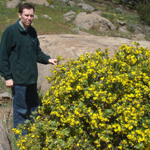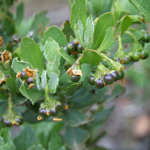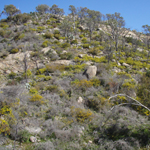Boneseed
Boneseed is a woody, erect shrub and can have an effect on native vegetation.
Common name:
- Boneseed
Scientific name:
Chrysanthemoides monilifera (L.) Norl.
Other common name:
- Bitou bush
Plant status
Catchment management authority boundaries
Regionally prohibited in the North Central, North East and East Gippsland catchment
Regionally controlled in the Mallee, Wimmera, Glenelg Hopkins, Corangamite, Goulburn Broken, West Gippsland, Port Phillip and Western Port catchments
Restricted in no areas in Victoria
Plant biology
Appearance
Shrub or bush.

Description
Boneseed is a woody, erect shrub growing to a height of 2 to 3m and 2 to 6m wide.
Stems
Stems are brown and hard, branching above ground level.
Leaves
Leaves are alternately arranged and oval-shaped with a tapering base and irregularly toothed margins. They are green in colour, 2 to 8cm long with thin blades.

Flowers
Flowers are bright yellow and daisy-like with 5 to 8 petals. Flowers are formed in late winter and spring, from August to October.
Fruit
Fruit of boneseed is globular, 6 to 8mm in diameter and light brown when dry. Seeds usually fall in January or February.
The plant bears fruit from spring through to autumn.
Growth and lifecycle

Method of reproduction and dispersal
Boneseed is spread by seed only. Germination is promoted by fire, soil disturbance, weathering and ingestion of seeds by animals. Most seed is dispersed by animals such as foxes and birds or through water. Seeds may also be spread in soil stuck to vehicles and equipment.

Rate of growth and spread
Boneseed flowers within 2 to 3 years in open areas. However, flowering can occur within 12 months after a fire. Growth is rapid, particularly in winter, and can invade both disturbed and undisturbed sites.
Seedbank propagule
Boneseed is a prolific seeder and mature boneseed plants can produce up to 50,000 seeds per plant. The seedbank for boneseed can remain viable for at least 10 years.
Preferred habitat
Boneseed is not restricted by climate, but prefers sandy or medium-textured soils and disturbed situations. It is well adapted to fire, responding more rapidly than native species, even to low intensity fire.
Young growth is sensitive to frost, but plants are rarely killed.
Boneseed will not tolerate waterlogged soil or prolonged drought.
Distribution
Boneseed can be found throughout south-eastern Australia and coastal New South Wales, where it is widespread, mostly as scattered plants or small populations.
Growth calendar
The icons on the following table represent the times of year for flowering, seeding, germination, the dormancy period of boneseed and also the optimum time for treatment.
| Jan | Feb | Mar | Apr | May | Jun | Jul | Aug | Sep | Oct | Nov | Dec | |
|---|---|---|---|---|---|---|---|---|---|---|---|---|
| Flowering | ||||||||||||
| Seeding |  | |||||||||||
| Germination | ||||||||||||
| Dormancy | ||||||||||||
| Treatment |
Impact
Impact on ecosystems and waterways
Boneseed impacts on native vegetation and can reduce the biodiversity values of bushland areas.
Dense infestations of boneseed can virtually eliminate native understorey species and reduce the regeneration abilities of native trees and shrubs. Its presence can also severely impact on several coastal plant communities.
The weed may negatively affect wildlife through the displacement of essential food plants.
Management
Prescribed measures for the control of noxious weeds:
- application of a registered herbicide
- physical removal.
Read more about prescribed measures for the control of noxious weeds.
Other management techniques
Changes in land use practices and spread prevention may also support boneseed management after implementing the prescribed measures.